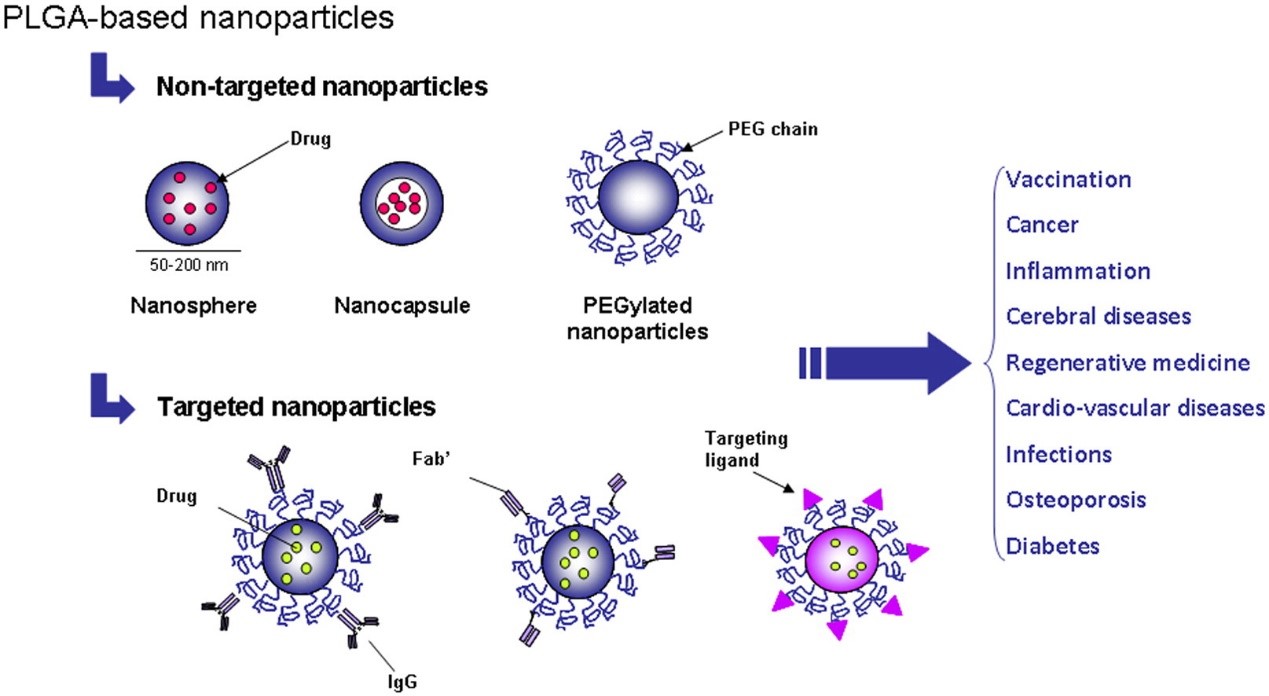In order to achieve therapeutic or immunological effects, drug or vaccine delivery systems must overcome barriers that typically result in drug degradation or ineffectiveness, such as biological barriers or requirements for specific environments at the desired site of action. Currently, several drug and antigen delivery platforms have been incorporated into clinical products, including non-viral vectors, molecular conjugates and nanoparticles. Among these, nanoparticles are a promising delivery platform that can be loaded with one or more different types of drugs and antigens, and can be easily synthesised and chemically and biologically modified. Nanoparticles range in size from 1 to 100 nm and can be naturally formed or engineered. Currently, the most commonly used nanoparticles include ferritin, lipoprotein, virus-like particles (VLPs) and polymer nanoparticles.
 Figure 1. PLGA-based nanoparticles of biomedical applications. (Danhier F, et al.; 2012)
Figure 1. PLGA-based nanoparticles of biomedical applications. (Danhier F, et al.; 2012)
Polylactic-co-glycolic acid (PLGA) nanoparticles are a kind of drug polymer carrier widely used in the biomedical industry, among which the research on targeted drug delivery is an important research direction of PLGA in the biomedical field. Studies have found that PLGA nanoparticles as drug and vaccine delivery systems show a series of favorable properties such as good bioavailability and compatibility, biodegradable polymer skeleton, and good safety. Therefore, PLGA is approved by the US Food and Drug Administration (FDA) and the European Medicines Agency (EMA) for human extraintestinal or mucosal use. PLGA nanoparticles can encapsulate drugs or antigens in nanoparticles, which can not only protect drugs or antigens from enzymatic hydrolysis, but also release drugs slowly; they can also be coupled to the surface of particles to play the role of antigen display. In recent years, the delivery platform built by modifying and transforming PLGA has provided support for research such as disease diagnosis, vaccine development and targeted therapy.
PLGA is a copolymer of lactic acid (LA) and glycolic acid (GA). Different monomer ratios can be used to prepare different types of PLGA, such as PLGA75:25, which means that the polymer is composed of 75% LA and 25% GA. By adjusting the ratio of LA to GA, the hydrophilicity of the nanoparticles can be affected. Within a certain range, the higher the LA content, the worse the hydrophilicity of the nanoparticles, and the slower the drug release. In addition, the ratio of LA to GA will also affect the crystallinity of PLGA. LA is crystalline, while GA is more amorphous. A higher content of GA will shift the ratio of crystalline and amorphous states in the nanoparticles to amorphous states, resulting in faster particle hydrolysis. When LA and GA each account for 50%, PLGA degrades fastest. The particle size and surface potential of PLGA will also affect its encapsulation rate and absorption rate. Studies have shown that in the antibacterial test of Gram-positive and Gram-negative bacteria, the diameter of the antibacterial zone of 45nm nanoparticles is greater than that of 114nm nanoparticles. Similar results have been found in cancer treatment, where ultra-small nanoparticles are more conducive to deep tumor penetration and uniform drug distribution.
In recent years, the pandemic of severe acute respiratory syndrome coronavirus 2 (SARS-CoV-2), African swine fever virus (ASFV), avian influenza virus (AIV), etc. has posed a huge threat to global human health. Therefore, new preparations need to be developed to treat and prevent infectious diseases. Vaccines prepared by polymer nanoparticles can improve the absorption of active ingredients, thereby reducing the immune dose. PLGA nanoparticles are representatives of polymer nanoparticles, and their mediated immunotherapy is a promising tool with a variety of potential applications. Among them, PLGA has been widely used in the study of nano vaccines as a nano delivery system, which can enhance the uptake of antigen presenting cells (APC) and induce humoral and cellular immune responses. The half-life of soluble antigens such as recombinant proteins is relatively short, mainly activating the major histocompatibility complex II (MHC-II) class pathway, and the immunogenicity is low, so adjuvants are needed to enhance the intensity of antigen-specific immune responses. Studies have shown that soluble antigens encapsulated in PLGA nanoparticles can be effectively taken up by antigen-presenting cells because the MHC-I pathway increases effective cross-presentation and CD8+ cytotoxic T cell activation.
In practical applications, researchers can select PLGA with corresponding monomer ratios (LA and GA) based on the properties of different drug molecules and drug release rates. The biodegradable nature of PLGA has led to extensive research in the field of drug delivery, mainly including the delivery of anti-cancer drugs, protein or peptide drugs, bacterial or viral DNA, etc.; it can also achieve targeted drug delivery and improve cell uptake effect of drugs. It is reported that curcumin can show anticancer activity against a variety of tumors, but the body's absorption capacity for curcumin is limited. Encapsulating it in PLGA nanoparticles is an effective strategy for delivering drugs to tumor sites. In addition, PLGA nanoparticles have a targeting effect and can reach specific cancer cells, thereby enhancing the anti-tumor effect of curcumin. The nanoparticles can successfully integrate the complex network of alternative cancer treatment and traditional treatment development. Atherosclerosis (AS) is a chronic inflammatory disease that affects the blood vessel wall. Statins are the main drugs for the treatment of dyslipidemia and play an important role in reducing cardiovascular risk. However, statins have low solubility, rapid metabolism, and low bioavailability, which makes their clinical application effect poor. Studies have reported that coupling PLGA with statins can increase their bioavailability and targeting, and reduce side effects.
Reference
1. Download the template.
2. Enter product information on the template (maximum number of products: 200).
3. Load the file using selector below.
1. Download the template.
2. Enter product information on the template (maximum number of products: 200).
3. Load the file using selector below.